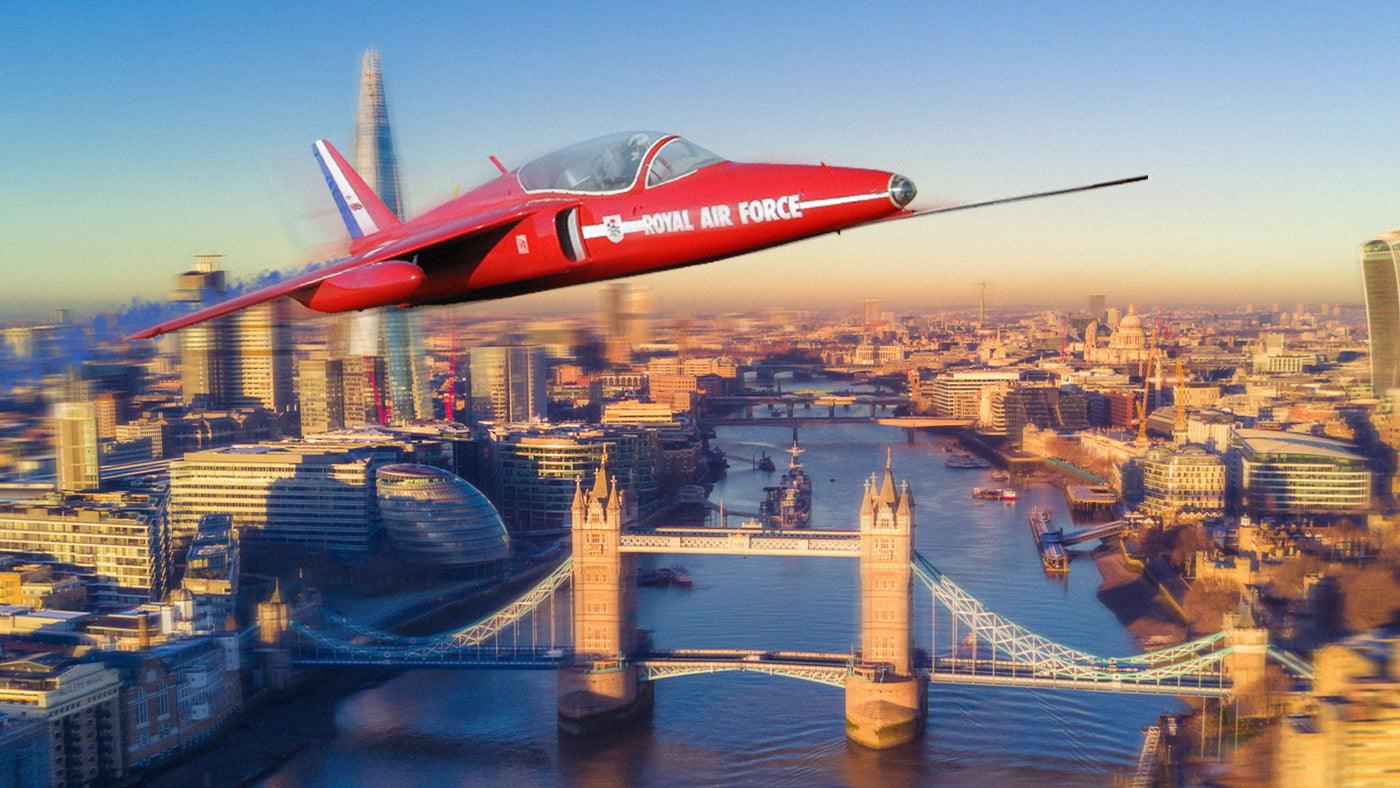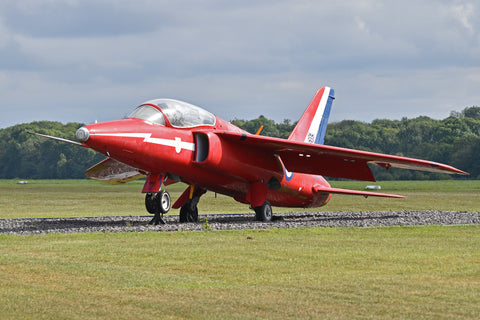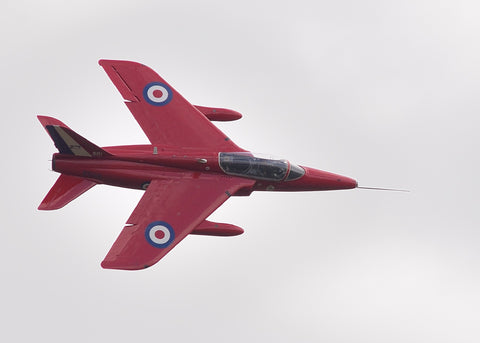
- by Dianna Lopez
Folland Gnat: The RAF Red Arrows Display Team Star
- by Dianna Lopez
A question? Visit our contact page
This site uses cookies for better user experience and analytics.

MotoArt owner Dave Hall received the Folland Gnat wing nearly 15 years ago. Since then, it has followed MotoArt from shop to shop, and hung on the wall as a striking representation of British aviation. Learn more about MotoArt’s Folland Gnat N572XR and find out why Hall believes it was time to take it off the wall and find a permanent home for it.


The Folland Gnat is a small, swept-wing subsonic fighter aircraft designed and built in the United Kingdom by Folland Aircraft. It was purchased as a trainer aircraft for the Royal Air Force (RAF) as well as by export customers, who utilized the Gnat in both combat and teaching capacities. The Gnat was envisioned as an affordable light fighter in contrast to the escalating cost and size of normal combat aircraft. The Gnat T.1 jet trainer derivative was adopted and deployed for a while by the Royal Air Force (RAF). With its history as the display aircraft of the RAF's Red Arrows aerobatic team for many years, the Gnat became a familiar and beloved sight within the United Kingdom and also to the rest of the world.

Folland Gnat flickr photo by Tim Spouge shared under a Creative Commons (BY-ND) license
Designed to be a compact, simplified fighter aircraft that could be manufactured inexpensively and with tools and facilities accessible to less industrialized nations, it was submitted to meet the British Air Ministry’s Operational Requirement OR.303. While the RAF never adopted the Gnat besides the trainer T.1, it was used by other nations including Finland. 449 were built.
It was designed as a combat aircraft, with ground attack and day fighter roles. It had a fully pressurized cabin and climate control. It offered advantages over a conventional fighter - it was low in cost, easily handled and serviced. It could operate from grass airstrips with its tricycle landing gear. It could be produced with minimal man-hours, with less machining, forging or casting, and with construction performed with simple jigs. They could also be assembled and disassembled quickly, without using cranes or ladders, and was much easier to service than most other aircraft of its type.

The Folland Gnats were used by the Royal Air Force for training pilots. After completing their initial training on the Hunting Percival-BAC Jet Provost, a British jet trainer aircraft, RAF pilots were chosen to fly in one of three paths: fast jet, multi-engine aircraft, or rotary (helicopters). Those chosen for fast jets were posted to RAF Valley on Anglesey and went through advanced training on the Folland Gnat T.1. They would then advance to the Hawker Hunter once they had achieved sufficient success, or usually after 70 hours.
The Gnats were taken out of service in April 1976 after the Hawker Siddeley Hawk was brought into the training role. In November 1978, the largest operator, 4 FTS at RAF Valley, decommissioned its final Gnat. Then, all operable aircraft were delivered to RAF Halton's No. 1 School of Technical Training, with other excess Folland Gnats being used as ground training airframes at various smaller training facilities. The training airframes were subsequently withdrawn by the RAF, and many of them were sold to private operators.

The Red Arrows are The Royal Air Force's aerobatic display team, formally known as the Royal Air Force Aerobatic Team. Similar to the U.S. Air Force Air Demonstration Squadron Thunderbirds or the U.S. Navy flight demonstration squadron the Blue Angels, the world-class aerobatics team represents the speed, precision, and capabilities of the Royal Air Force. The Red Arrows are a team of pilots, engineers and support staff, all of whom have frontline, operational experience.
The Red Arrows began in 1964, when the Royal Air Force merged its many display teams - the Black Arrows, Red Pelicans, and the Yellowjacks into one official unit. The team, using seven Gnats from the Yellowjacks, embarked on their first season in 1965. In 1968, the team increased to nine aircraft and began showcasing their trademark formation, the Diamond Nine.

Photo of the Diamond Nine by Tony Hisgett from Birmingham, UK, CC BY 2.0, via Wikimedia Commons
After flying 1,292 displays, the Folland Gnat was replaced for the 1980 season by the BAE Systems Hawk. They moved from RAF Kemble, their home since 1996, to their current base at RAF Scampton. Since then, the team has performed thousands of displays at airshows and during many important occasions. In 2002, they flew over London, accompanied by a British Airways Concorde, to commemorate Her Majesty the Queen’s Golden Jubilee. In 2012, they did another flypast for the Queen’s Diamond Jubilee and 2012 Olympics Games opening ceremony. In 2014, the Red Arrows celebrated their own 50th display season, with a succession of celebrations throughout the year. They have also taken center stage in celebrations marking the 100 year anniversary of the Royal Air Force in 2018.
Watch the Royal Family enjoy the Red Arrows flypast from the Buckingham Palace balcony, in celebration of the Queen's 70 years of service in 2022. More than 70 aircraft flew past, including Boeing AH-64 Apache helicopters, Hawker Typhoons, and the Red Arrows.

Photo taken by Adrian Pingstone at Kemble Airfield, Gloucestershire, England in June 2004 and released to the public domain.
To become a Red Arrows pilot, a Royal Air Force pilot must 1) have a minimum of 1,500 operational hours, and 2) be assessed as above average in their flying role. Up to three new pilots are chosen every year, to replace three pilots who have finished their tour. A shortlist of no more than nine applicants go through a grueling selection week, with flying tests, a formal interview, and other assessments. To become a Team Leader, one must have completed a three year tour as a Red Arrows pilot previously and go through a separate process.

 Photo by Simon W. Taken at Farnborough in 1978. XR572 is included.
Photo by Simon W. Taken at Farnborough in 1978. XR572 is included.
Serial number FL562, was built in 1963 and was delivered to the Royal Air Force on November 1, 1963. Now known as XR572, it was first used as a training aircraft. Around August 1974 it was transferred to the Red Arrows and became a part of the famed Red Arrows Demonstration team. With 2,960 flight hours on the airframe, it took its last flight September 16, 1979. It was then transferred to the School of Aircraft Handling, RNAS Culdrose, Cornwall and assigned a new serial number, A2676 RAF. In April 1986, it was withdrawn from use at the school and officially retired.

Folland Gnat T1 XR572 / N572XR in the markings of the RAF Red Arrows display team, taken in June 2006 at the Rocky Mountain Metropolitan) Airport Open House. The plane actually flew as Red Arrows #3 while in RAF service.
Photo by Kristian Jones, Public domain, via Wikimedia Commons
The plane made its way across the Atlantic and was bought by a private owner in 1989 and registered as N572XR. Its wing had been damaged and was replaced by the Spirit of Flight Foundation, which is how MotoArt acquired the original wing. It was used as the Folland Gnat in Hot Shots (1991).

The Folland Gnat wing has been a familiar sight at MotoArt Studios in Southern California for many years. Originally MotoArt owner Dave Hall thought it would someday be transformed by the design team into an exquisite, one-of-a-kind aviation desk. As time went on, and as the demand grew for PlaneTags from such notable vintage aircraft as the Gnat, Hall began to dream of a different purpose. Hall, along with the rest of the world, watched as the longest-reigning monarch in Britain’s history passed on, with a new King and the Head of the Commonwealth taking her place. “Our Folland Gnat flew in demonstrations for Her Majesty the Queen and the British people,” says Hall. “It seemed selfish to keep the Gnat wing up on our wall or create one piece of furniture.”

The team went to work right away on creating Folland Gnat PlaneTags. Watch the project from start to finish on the Folland Gnat PlaneTags playlist on the MotoArt YouTube channel.
Here is a glimpse of the team cutting it up for PlaneTags.




Enjoy these additional production images of Folland Gnat PlaneTags manufacturing.



The Folland Gnat PlaneTags will be released at 12pm PDT Thursday, September 29, 2022 on planetags.com and on the PlaneTags app. The special edition series will be numbered to less than 1,500 and will be available in red, with some very limited combinations of white/red and blue/red, and white, which were taken from the roundel.
N466FE “Gideon”: The FedEx Boeing 727 That Kept the World Moving
From Warbird to Water Bomber: The Epic Life of the Hawaii Mars
In the world of aviation, few aircraft have lived a life as large, or as long, as the Hawaii Mars. Towering over most of its contemporaries with a wingspan of 200 feet, this mighty flying boat was born in the final days of World War II, then quietly transformed into one of the most iconic aerial firefighting aircraft the world has ever seen. From military transport to firefighting titan, the Hawaii Mars represents one of aviation’s most extraordinary second acts.
In 2025, MotoArt obtained an original wing of this aircraft and created special PlaneTags, made exclusively for the Martin family members and Mars workers. On December 11, 2025, Hawaii Mars PlaneTags will be available to the general public for the first time.
F-14 Tomcat Coasters: A Legendary Fighter Reimagined for Your Home
Few aircraft define an era quite like the Grumman F-14 Tomcat. Sleek, powerful, and unmistakably iconic, the Tomcat was the Navy’s premier fleet defense fighter for more than three decades. From Cold War missions to pop culture stardom, the F-14 remains one of the most recognizable and beloved aircraft ever built. Today, MotoArt is proud to introduce the F-14 Tomcat Coaster Set, created from authentic F-14 aircraft material.


Share:
F-4 Phantom: An Enduring Frontline Fighter
General Aviation Icons: Beechcraft G35 Bonanza & Cessna 402C Businessliner